Guitar tablature, or “guitar tab,” is an accessible and user-friendly form of musical notation that allows aspiring guitarists to quickly begin learning their favorite songs. Think of a Guitar Chords Tablature Chart as your personal roadmap to musical fluency on the guitar. While sharing some similarities with traditional music notation by indicating note duration, rhythm, and techniques, guitar tabs excel by visually representing where to play those notes directly on your guitar. This is incredibly beneficial, especially considering the guitar’s layout where the same note can be played in multiple positions across the fretboard. For beginners, understanding and utilizing guitar tablature charts eliminates the initial hurdle of learning standard musical notation, making it a powerful tool for immediate musical engagement.
At guitarplayers.net, we recognize the immense value of guitar chords tablature charts, particularly for those just starting their musical journey. Guitar tabs efficiently display both chords and single notes, offering the quickest route to learning songs. The beauty of tablature lies in its simplicity; no prior musical knowledge is needed beyond understanding the strings and frets on your guitar. A guitar chords tablature chart is your visual guide, translating musical ideas into actionable finger placements.
If you’re eager to demystify guitar tabs and explore their capabilities, you’ve landed in the perfect spot. Let’s dive into the world of guitar tablature and unlock your guitar playing potential.
Decoding Guitar Tablature: What is a Guitar Tab?
A guitar chords tablature chart, at its core, is a visual representation of music tailored specifically for guitar. Imagine a song’s notes translated into a guitar-centric language. A standard guitar tab is composed of six horizontal lines, each symbolizing one of the six guitar strings. When reading a guitar chords tablature chart, you interpret it from top to bottom. The uppermost line represents the high E string (the thinnest), descending to the B, G, D, A, and finally the low E string (the thickest) at the bottom.
This arrangement mirrors the perspective you have when looking down at your guitar in playing position. Therefore, consider a guitar chords tablature chart as your direct navigation system, providing the most efficient path to mastering guitar songs.
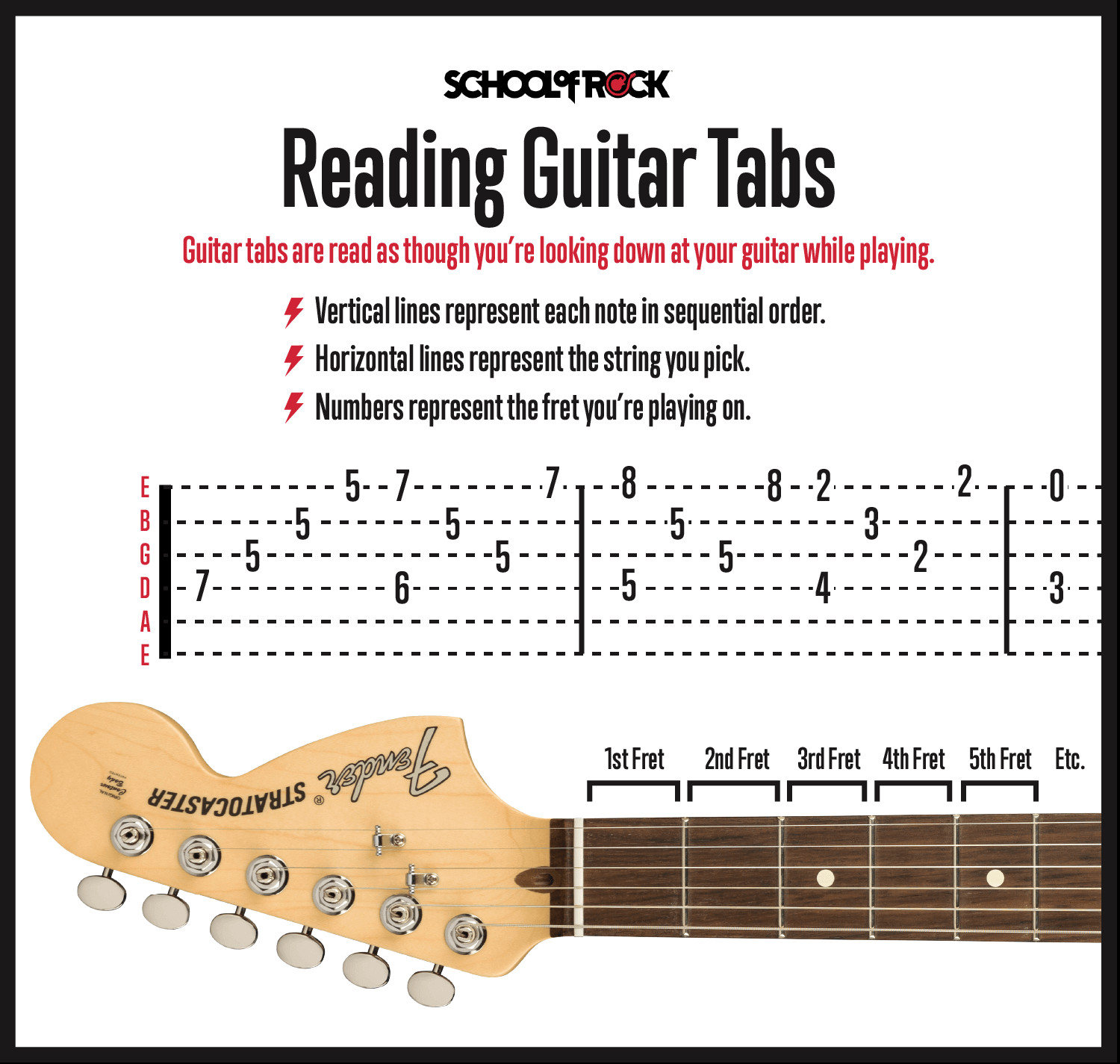 Reading guitar tabs
Reading guitar tabs
Image alt text: A visual guide illustrating how to read guitar tablature, highlighting the correspondence between tab lines and guitar strings.
Within a guitar chords tablature chart, you’ll notice numbers placed on these lines. These numbers indicate the frets on your guitar – the metal strips along the fretboard. Frets are numbered from 0 to 24, starting at the nut (closest to the headstock) and extending down the neck.
A ‘0’ on a string means playing it “open,” without fretting. A ‘1’ signifies playing at the first fret. When learning to read a guitar chords tablature chart, remember that ‘1’ is the first fret, ‘2’ is the second, and so on. This numerical system directly corresponds to finger placement on the fretboard, making it incredibly intuitive for beginners.
 Play Button
Play Button
How to Read Guitar Tablature Charts Effectively
Reading a guitar chords tablature chart is a linear process, moving from left to right, with notes presented in chronological order. When numbers align vertically, they represent a chord. A chord in a guitar chords tablature chart signifies that you should strum all the indicated strings simultaneously. For beginners, this is a much more straightforward approach than standard notation, as the tab clearly shows both the notes and their location on the guitar neck needed to form a chord.
Essential Knowledge for Reading Guitar Tablature Charts
To successfully navigate a guitar chords tablature chart, beginners should first become familiar with the six guitar strings and the positioning of the frets. This foundational knowledge allows you to quickly locate the correct notes on your guitar as indicated by the tablature, transforming the chart into a practical guide for playing.
Understanding the Guitar Tab Staff
The staff in a guitar chords tablature chart visually resembles the staff used in standard music notation, but with a crucial difference. In tab, the lines represent the 6 guitar strings, not musical pitch as in standard notation.
The top line is always the high E string, and the bottom line is the low E string. This direct string-to-line correlation simplifies learning and makes reading a guitar chords tablature chart beginner-friendly. Furthermore, a tab staff is typically labeled “TAB” to avoid confusion with standard notation.
Deciphering Guitar Frets on Tab Charts
Guitar frets, the metal strips across the fretboard, are the numerical markers in a guitar chords tablature chart.
Most guitars feature between 19 and 24 frets. Each fret represents a half step (or semitone) in pitch from the next. Within each octave, there are 12 frets/notes. Guitars often have fret markers (inlays) on the side of the neck or fretboard, typically at the 3rd, 5th, 7th, 9th, and 12th frets. These markers are invaluable for quickly identifying fret positions while playing and using a guitar chords tablature chart.
Remember, in a guitar chords tablature chart, fretted strings are indicated by numbers (1, 2, 3, etc.), while an open string is represented by “0”. The “0” signifies playing the string without pressing down on any fret – simply pluck or pick the string.
Reading Guitar Chord Diagrams within Tablature
While guitar chords tablature charts don’t use special symbols for chords, they are easily identifiable by their vertical arrangement. When multiple numbers are stacked vertically in a tab, it indicates a chord – notes to be played together simultaneously. If a chord is arpeggiated (played one note at a time), it will appear as a sequence of single notes in the guitar chords tablature chart, even though you are still forming the chord shape with your fretting hand.
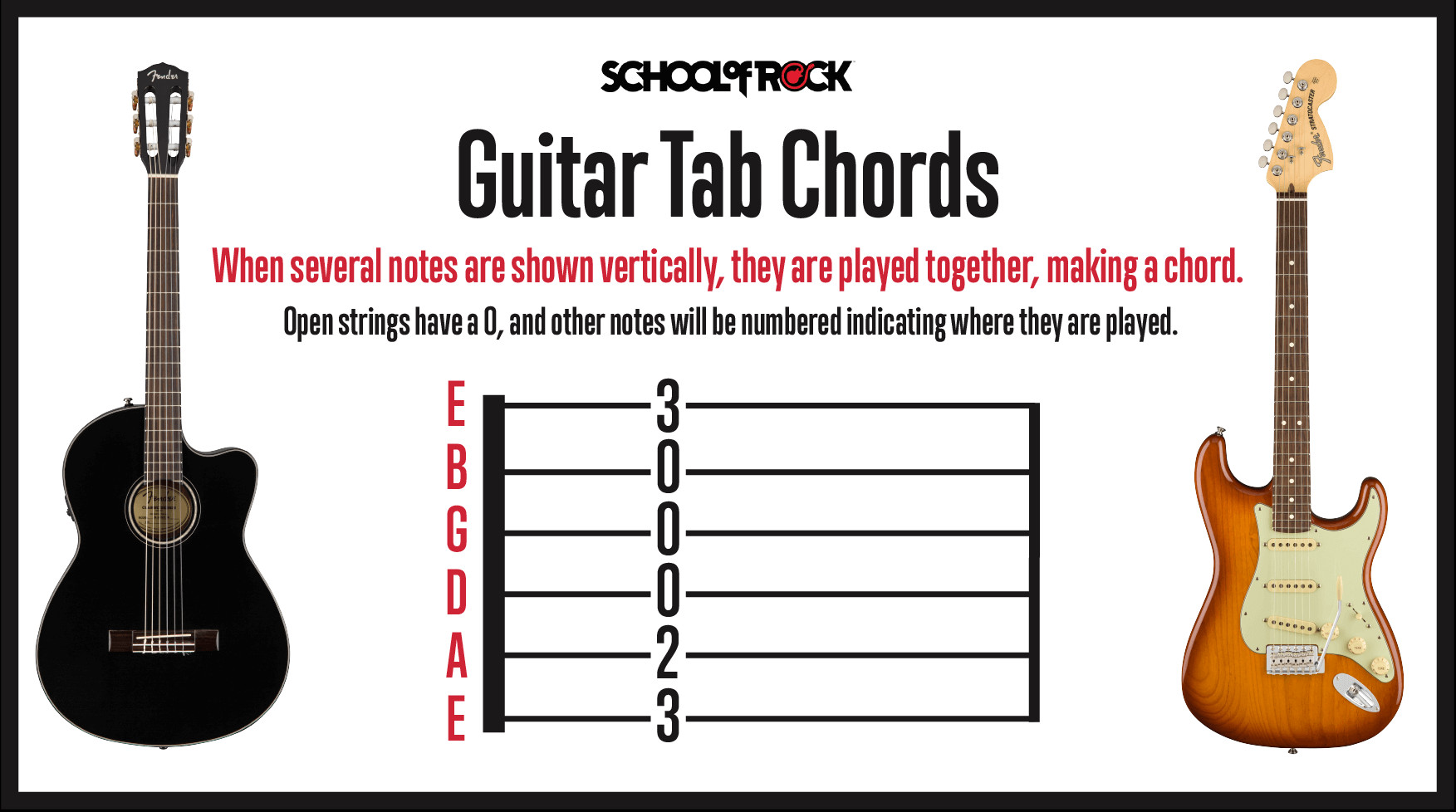 How to read guitar tab chords
How to read guitar tab chords
Image alt text: An illustration on reading guitar tab chords within a guitar chords tablature chart, demonstrating vertical note alignment for simultaneous play.
Understanding Guitar Riffs in Tablature
Many popular songs, especially in rock genres, are built around “riffs”. Riffs are short, repeated musical phrases often combining single notes and partial chords, like power chords. When reading riffs in a guitar chords tablature chart, the same principle applies: vertically aligned notes are played together. This consistent approach makes learning riffs from a guitar chords tablature chart straightforward.
Guitar Tablature Charts vs. Standard Chord Charts
A guitar chords tablature chart differs from a standard chord chart in presentation and information. A chord chart is a diagram illustrating finger placement for a chord, often including finger numbers. Chord charts are frequently included above song lyrics to indicate chord changes.
Chord charts primarily show the essential 3-4 notes of a chord. However, a full song arrangement may include single notes, notes outside the basic chord, or arpeggios, which are not always shown in a simple chord chart. Therefore, guitar chords tablature charts are often used alongside chord charts. The tab provides a more complete musical picture, while chord charts can be a quick reference for basic chord shapes, aiding beginners in transitioning from simple chords to more complex song arrangements.
Finger Numbering in Chord Charts (Complementary to Tablature)
While guitar chords tablature charts are linear representations, chord charts offer a “snapshot” of the fretboard for specific chords. Chord charts use a numbering system to indicate which fingers to use for each string. The fingers of your fretting hand are numbered: 1 (index), 2 (middle), 3 (ring), and 4 (pinky).
This finger numbering is distinct from tablature, where numbers indicate frets, not fingers. Chord charts integrated with guitar chords tablature charts can assist beginners by suggesting efficient fingerings for chord shapes, complementing the fret-based information in the tab.
Play Guitar in Real Performances Onstage
Our music programs are led by experienced, practicing musicians who provide the expertise you need to learn and excel. Gain real-world performance experience and hone your guitar skills in a supportive environment designed for all levels of players.
Decoding Guitar Tab Symbols: Beyond Notes and Chords
Beyond lines and numbers, a guitar chords tablature chart uses various symbols to indicate specific playing techniques. Understanding these symbols is crucial for authentic and nuanced guitar playing.
Always ensure your guitar is correctly tuned before playing, regardless of the guitar chords tablature chart you are using. Accurate tuning is fundamental for proper pitch and sound. You can check out our guitar tuning guide for assistance.
Muting Guitar Notes: Adding Depth and Dynamics
Muting is a vital technique, particularly in genres like Rock, Metal, Punk, and Alternative. Different muting techniques impart unique sonic textures and character to the music.
How to Execute Guitar Note Muting
Muting can be achieved with either the picking hand, the fretting hand, or both. It adds dynamic variation to your playing, creating a more polished sound. Many songs utilize muting in verses for contrast with unmuted choruses or hooks.
Experienced guitarists often employ muting instinctively to eliminate unwanted noise and feedback, especially at higher volumes.
Palm Muting Technique in Guitar Tablature
Palm muting is a frequently used rock guitar technique. It involves lightly resting the palm of your picking hand on the strings near the bridge while picking. Heavy palm muting produces a tight, percussive sound, while lighter palm muting allows notes to sustain slightly longer. In a guitar chords tablature chart, palm muting is typically indicated by “P.M.” above the section where it should be applied.
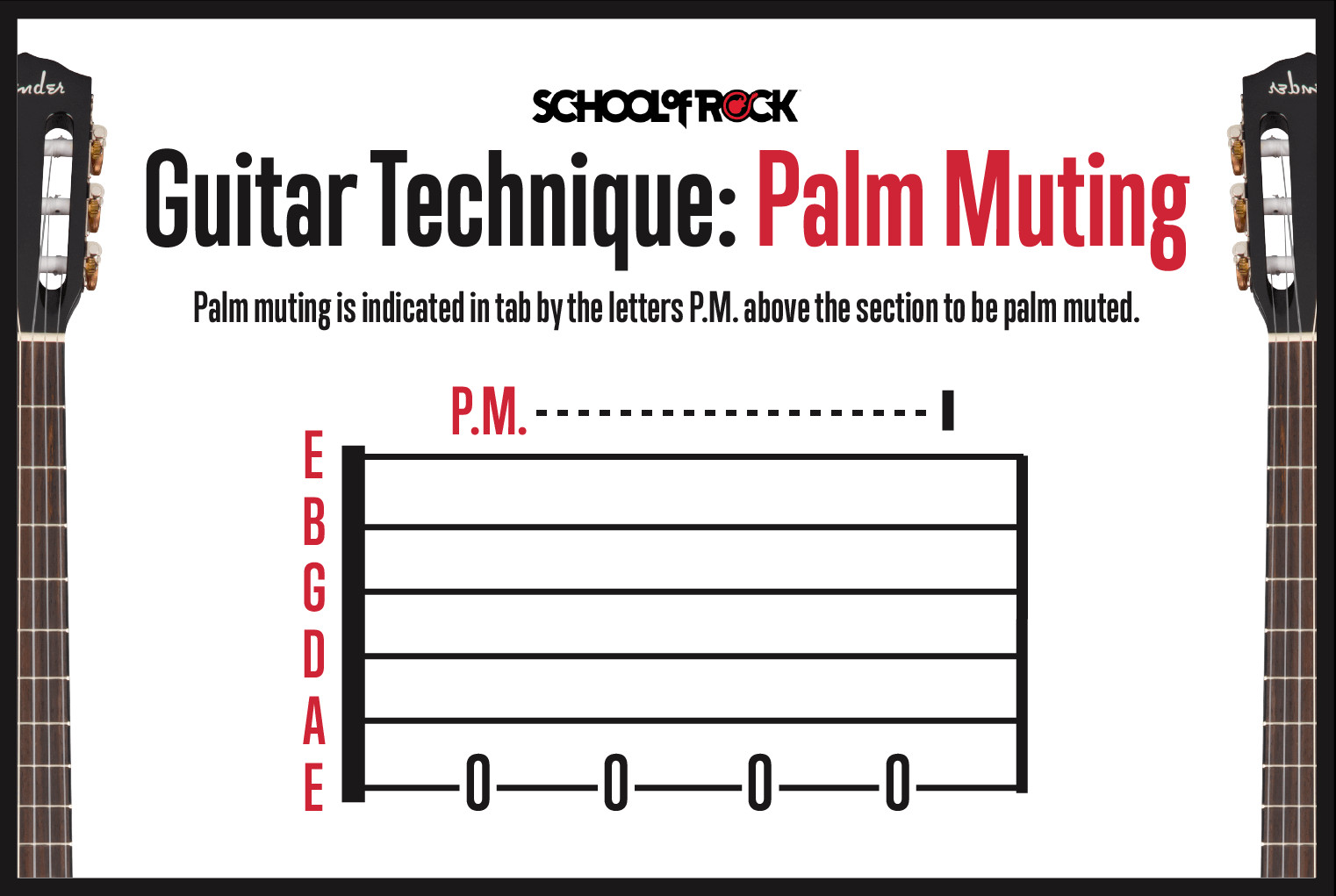 Guitar technique palm muting
Guitar technique palm muting
Image alt text: Visual representation of the palm muting guitar technique as indicated in a guitar chords tablature chart, showing hand placement and notation.
Muted Notes Technique in Guitar Tablature
Muted notes, distinct from palm muting, are executed with the fretting hand. In a guitar chords tablature chart, muted notes are still picked, but the fretting hand lightly touches the strings without fully pressing them down to the fretboard. This creates a percussive, less defined pitch. Muted notes are represented by an “X” in the tab where a fret number would normally appear.
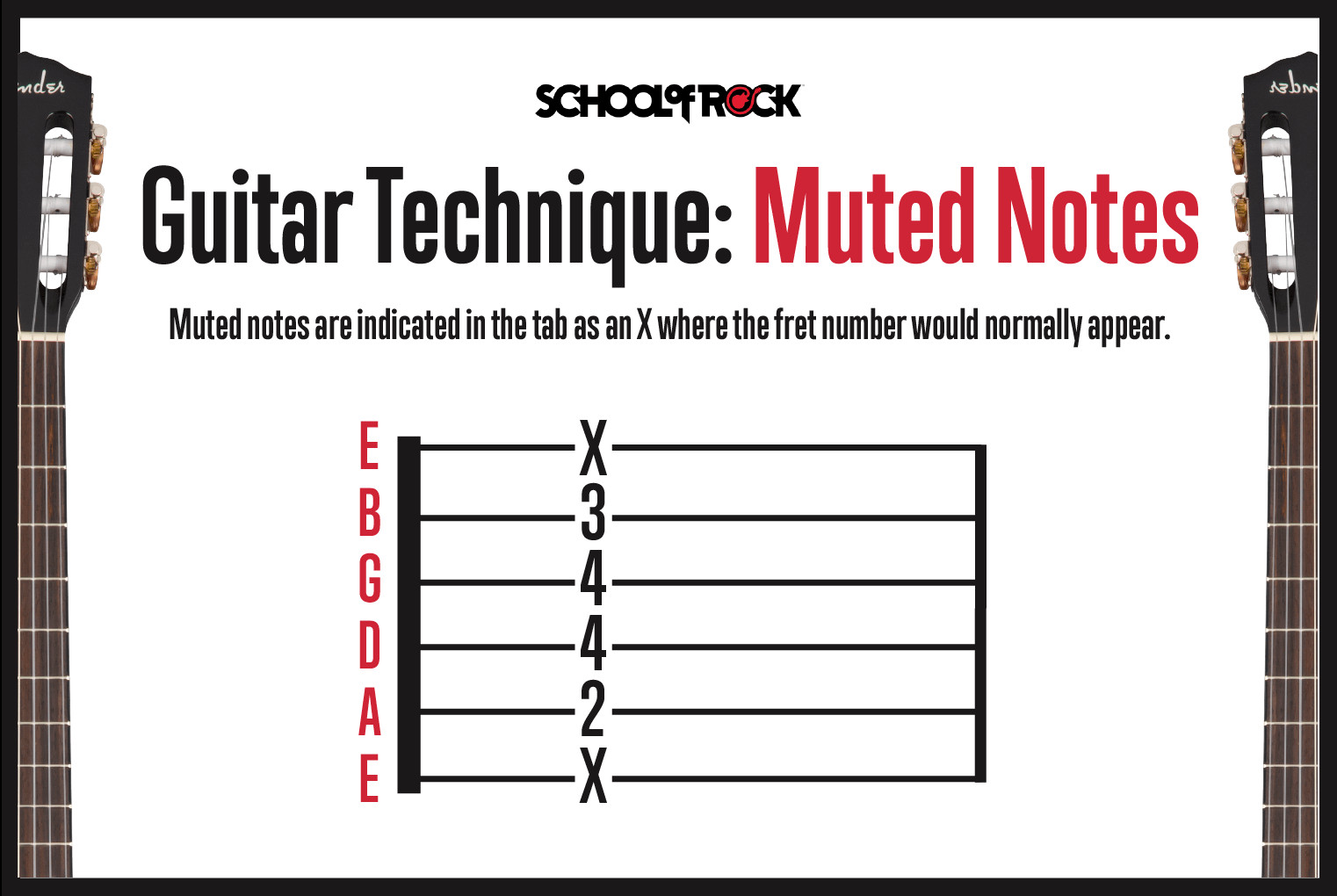 Guitar technique muted notes
Guitar technique muted notes
Image alt text: Explanation of muted notes technique in guitar chords tablature charts, showing ‘X’ notation and fretting hand position.
Bending Guitar Strings: Adding Vocal Expression
String bending adds an expressive, vocal-like quality to guitar playing. In a guitar chords tablature chart, bends are indicated by a curved arrow over the note. This arrow signifies increasing the string’s pitch. The arrow may specify “½” or “full,” indicating a half-step (one fret) or full-step (two frets) bend, respectively. These target pitches are often called “target notes”.
How to Bend Guitar Strings Effectively
Bending involves pushing the string up or down, rather than pressing directly onto the fretboard. For most strings (except low E), push upwards towards the ceiling; the low E string is pushed downwards towards the floor. Maintain consistent, even pressure throughout the bend for smooth pitch control.
String Bending Technique in Guitar Tablature
Most bends utilize 2-3 fingers for support: the primary fretting finger (usually the ring finger) and the middle and index fingers for added strength and control. This multi-finger technique facilitates smoother bends and more accurate pitch.
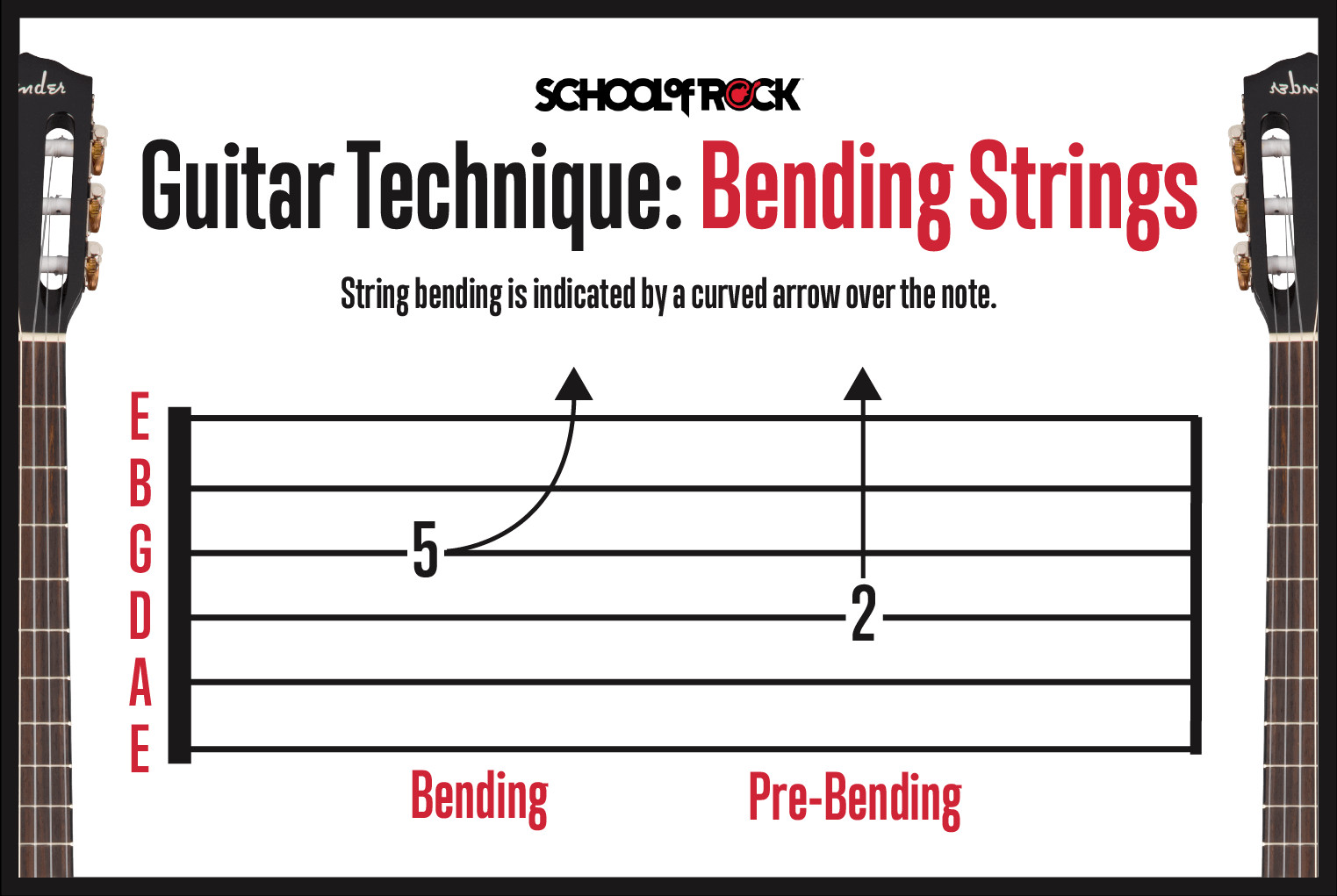 Guitar technique bending strings
Guitar technique bending strings
Image alt text: Demonstration of string bending technique in guitar chords tablature, emphasizing finger support and curved arrow notation.
Pre-bending Guitar Strings in Tablature
When learning to read guitar chords tablature charts, you might encounter “pre-bends.” A pre-bend involves bending the string before picking it, then picking the pre-bent note and potentially releasing it back to its original pitch. Pre-bends are notated with an upward arrow showing the bend amount (full, ½, etc.), followed by a downward curved arrow indicating the release. Pre-bent notes may return to the original pitch or bend further to another target note.
Sliding Guitar Notes: Smooth Transitions
Sliding is another essential technique for smoothly connecting notes. You can slide up or down the fretboard to reach the next note. Sliding differs from bending as it involves moving the fretting finger along the fretboard to the target fret, maintaining contact with the string.
Slide Up Technique in Guitar Tablature
In a guitar chords tablature chart, a slide up is shown by a line connecting the starting note to the destination note. An upward slanting line indicates a slide to a higher-pitched note.
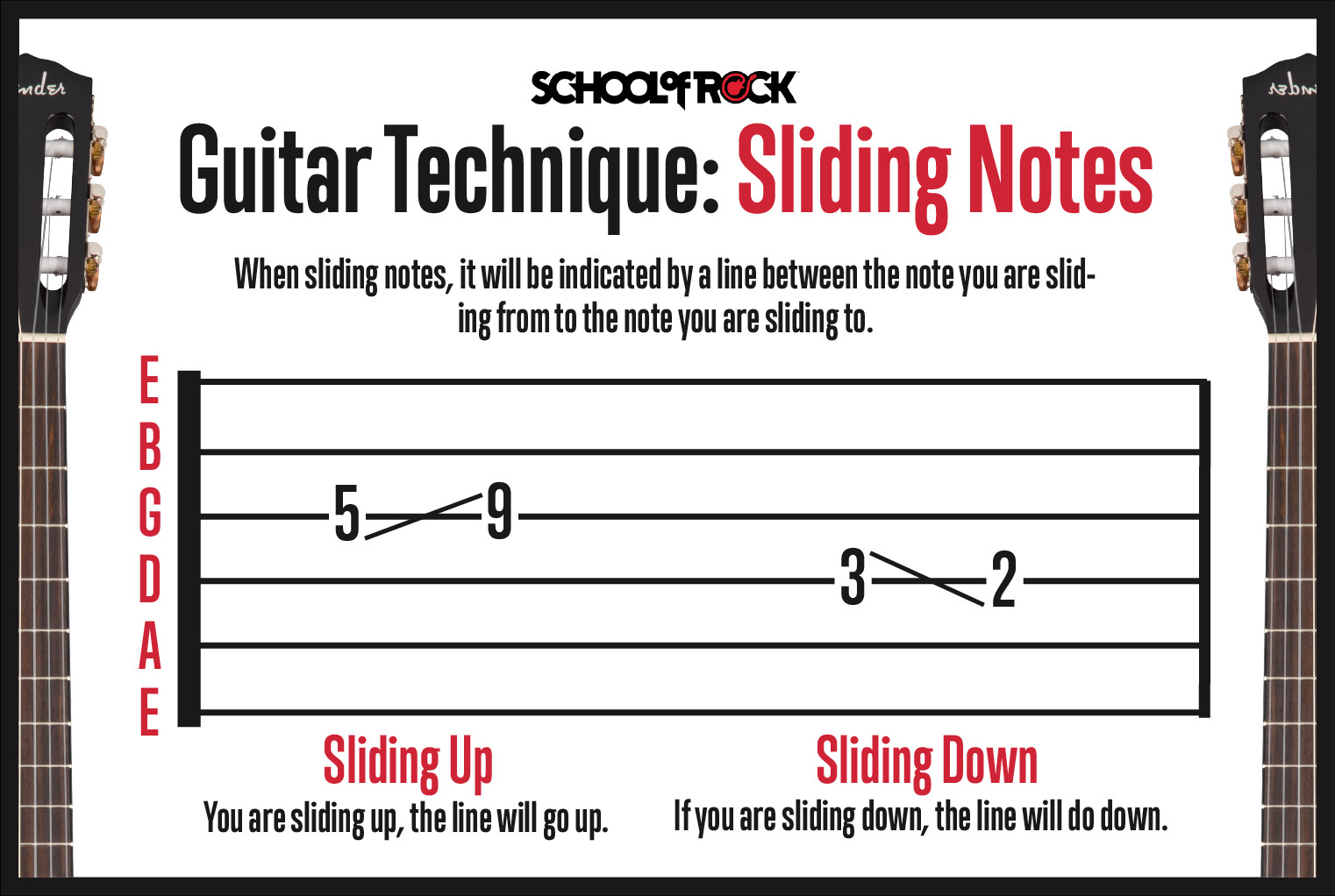 Guitar technique sliding notes
Guitar technique sliding notes
Image alt text: Illustration of slide up technique in guitar chords tablature, showing upward line notation for sliding to a higher fret.
Slide Down Technique in Guitar Tablature
Conversely, a slide down in a guitar chords tablature chart is also represented by a line between notes. A downward slanting line indicates sliding to a lower-pitched note.
Hammer-Ons on the Guitar: Creating Legato
A hammer-on is a technique where you produce a note by “hammering” your fretting finger onto the string, without picking it separately. You can hammer-on from an open string or a fretted note, resulting in a higher pitch. In a guitar chords tablature chart, hammer-ons are shown by the letter “H” and an arc connecting the initial note (open or fretted) to the hammered-on note.
How to Perform Hammer-Ons
To execute a hammer-on, strike the string with your fretting finger with enough force to sound the note clearly. This requires practice to achieve a strong, defined tone. Electric guitars with higher gain settings often make hammer-ons easier to perform. Practice starting with an open low E string and hammering onto the third fret, allowing the note to ring. Repeat this on different strings and frets.
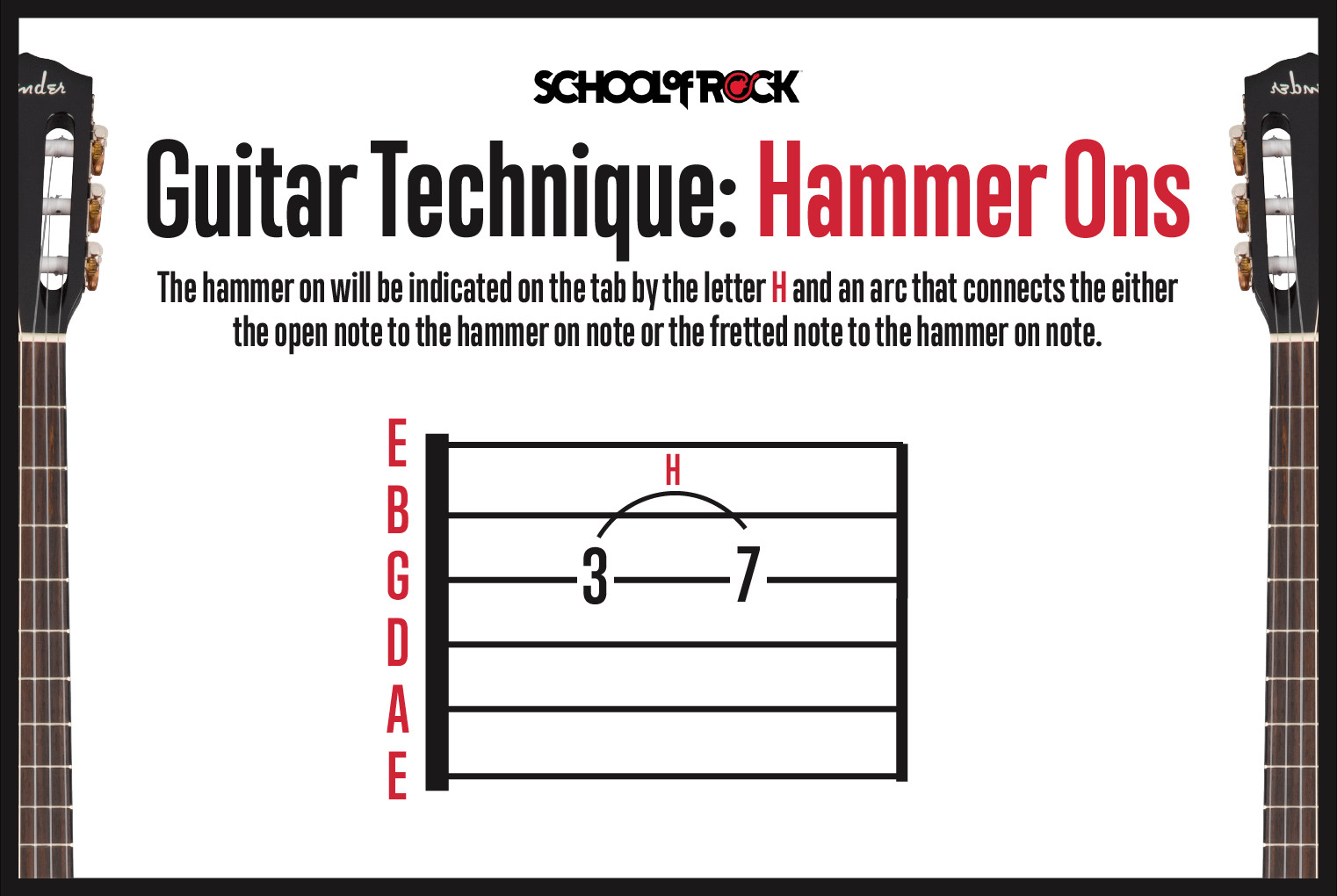 Guitar technique hammer ons
Guitar technique hammer ons
Image alt text: Visual guide to hammer-on technique in guitar chords tablature, demonstrating ‘H’ notation and finger hammering action.
Pull-Offs on the Guitar: The Reverse of Hammer-Ons
Pull-offs are the opposite of hammer-ons. Instead of hammering on, you “pull off” a fretted note to sound either an open string or a lower fretted note. In a guitar chords tablature chart, pull-offs are indicated by the letter “P” and an arc connecting the pulled-off note to the resulting lower note (open or fretted).
How to Execute Pull-Offs
To perform a pull-off, fret a note, then pull your finger off the string in a sideways, downward motion, effectively plucking the string as you release pressure. This action sounds a lower note, either an open string or a note fretted by another finger on the same string.
Hammer-ons and pull-offs can be combined in alternating sequences to create trills or fast legato passages.
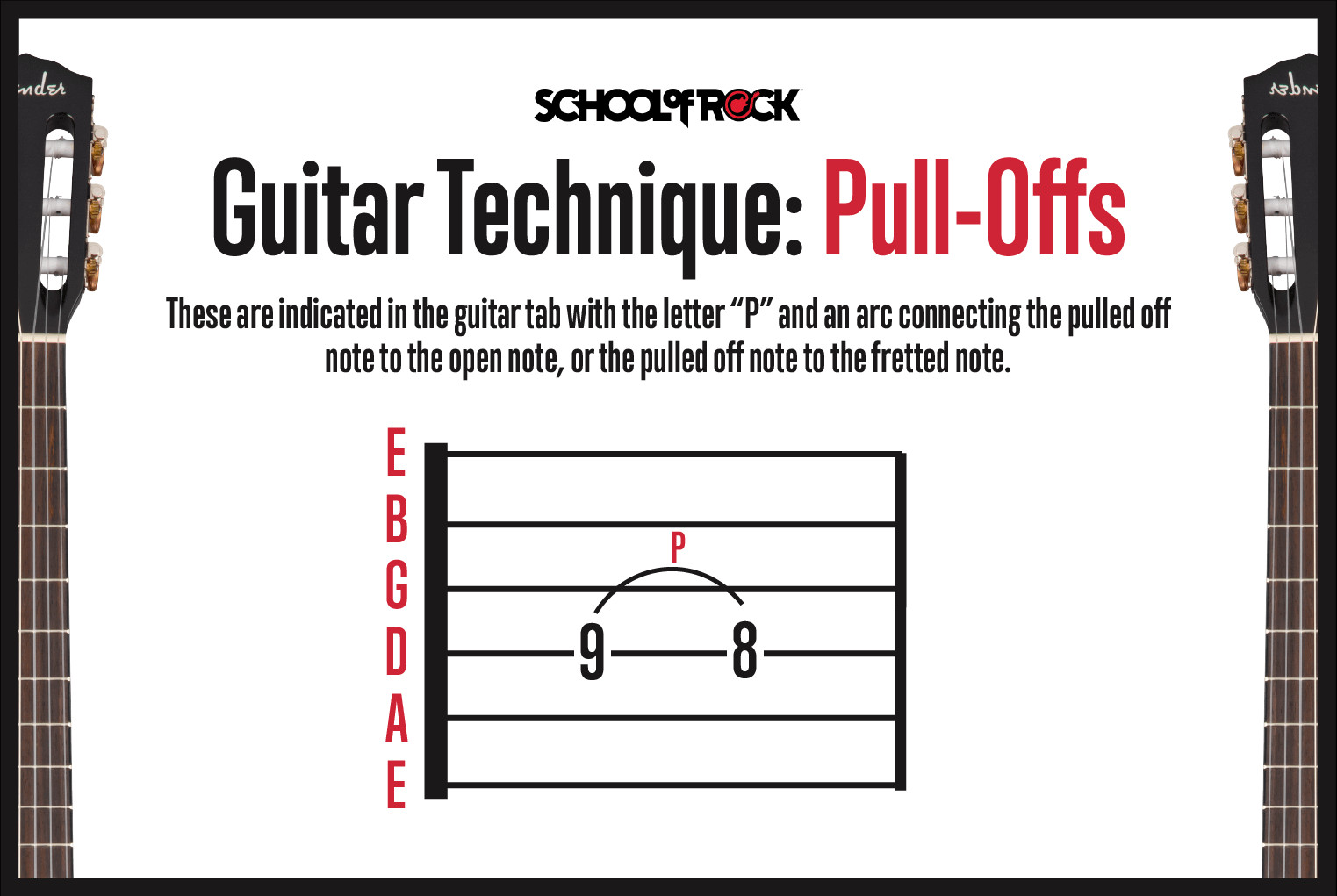 Guitar technique pull offs
Guitar technique pull offs
Image alt text: Explanation of pull-off technique in guitar chords tablature, showing ‘P’ notation and finger pulling action.
Vibrato on the Guitar: Adding Sustained Expression
Vibrato is a technique involving subtle, rapid bending and releasing of a note around its original pitch, creating a wavering, expressive tone. In a guitar chords tablature chart, vibrato is represented by a zig-zag line above the staff. The length of this line often indicates the duration of the vibrato effect.
How to Create Vibrato
Vibrato is similar to bending but with smaller pitch variations and faster repetitions. You can apply vibrato with a single finger or with multiple fingers for support. Start with a slow, smooth vibrato and experiment with speed variations for different expressive effects. Like bending, vibrato is a highly personal technique, contributing to a guitarist’s unique sonic signature.
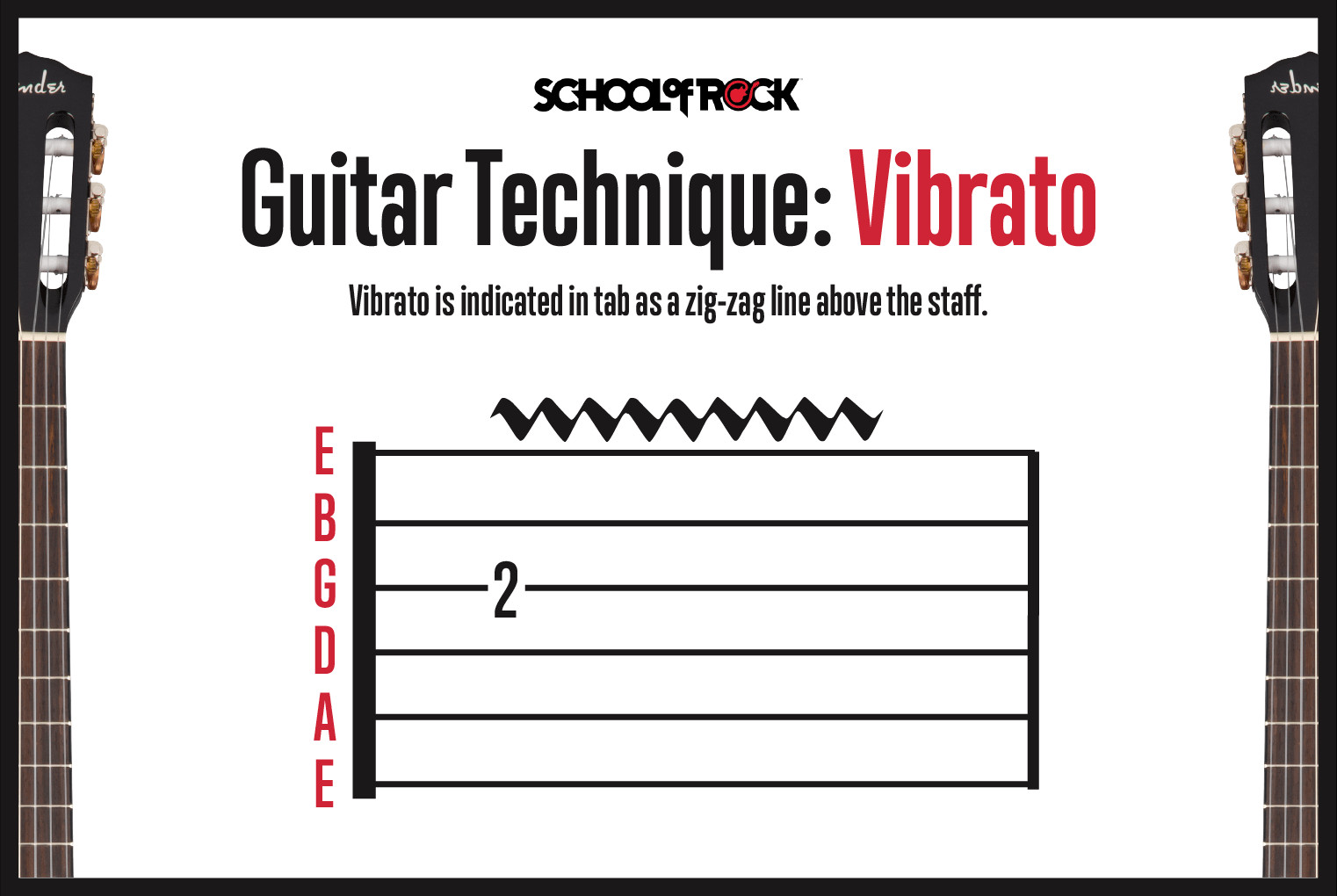 Guitar technique vibrato
Guitar technique vibrato
Image alt text: Visual representation of vibrato technique in guitar chords tablature, highlighting zig-zag line notation and finger rocking motion.
Tapping Guitar Techniques: Expanding Your Range
Tapping involves using the index finger of your picking hand to fret notes on the fretboard, in addition to your regular fretting hand. This “tapping” motion is essentially a hammer-on performed by the picking hand. In a guitar chords tablature chart, tapping is notated with a “T” above the tapped note.
How to Finger Tap
Eddie Van Halen popularized tapping, though the technique has roots in classical guitar. To tap, fret a note with your fretting hand and then tap a higher note on the same string with your picking hand’s index finger.
Tapping extends your playing range, allowing wide intervals and fast passages impossible to reach with just the fretting hand. Higher gain and volume levels often enhance the clarity and sustain of tapped notes. Two-handed tapping further expands possibilities by enabling independent note fretting with both hands.
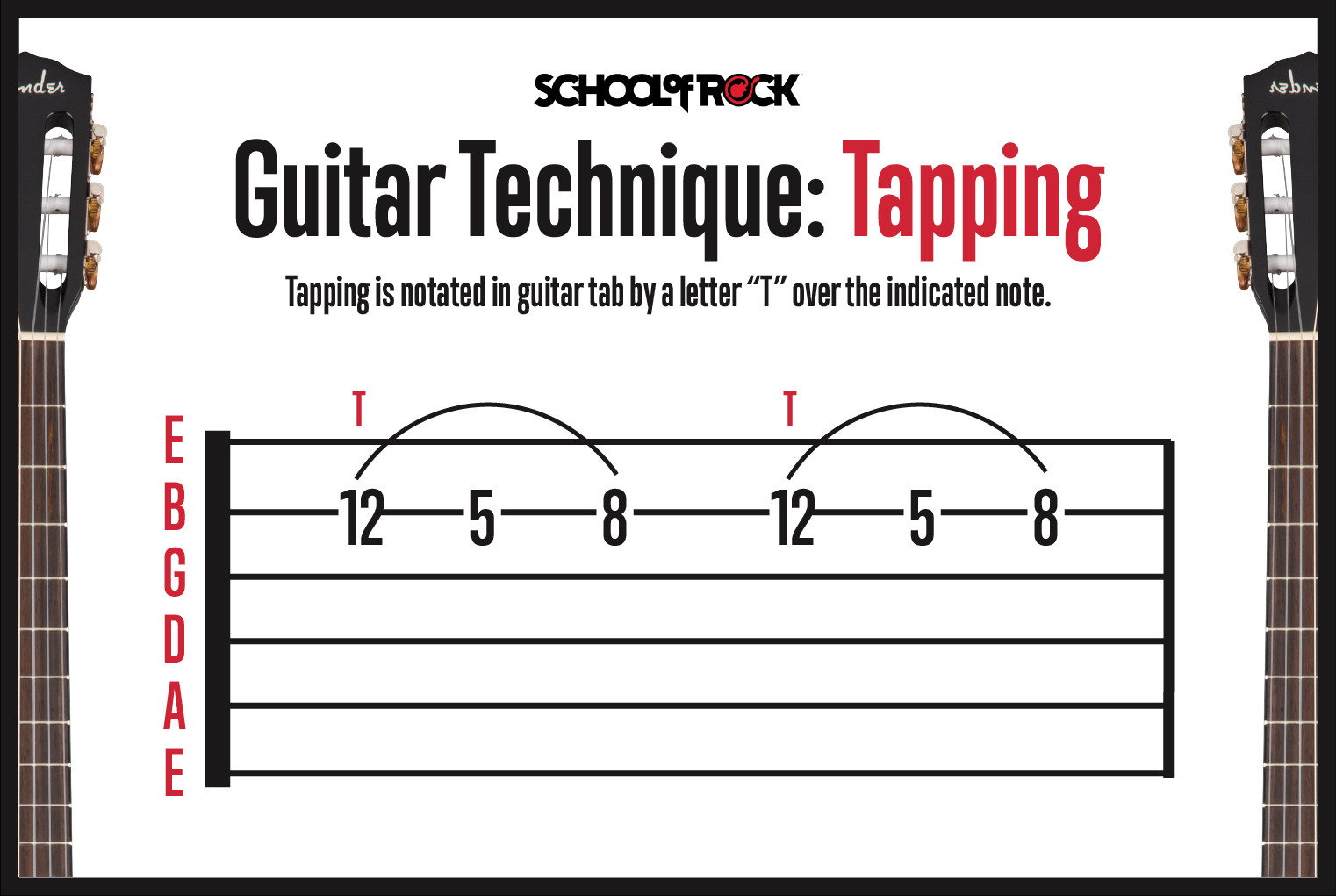 Guitar technique tapping notes
Guitar technique tapping notes
Image alt text: Demonstration of tapping technique in guitar chords tablature, showing ‘T’ notation and picking hand tapping on the fretboard.
Two-Handed Tapping Technique
Two-handed tapping involves both hands independently fretting notes without traditional picking. Both fretting and picking hands use hammer-on motions to produce notes. This technique can be used for playing bass lines with the fretting hand and melodies or solos with the picking hand simultaneously.
Strumming Guitar Notes: Rhythm and Texture
Strumming is fundamental for playing chords rhythmically. Two primary strumming strokes are used: downstrokes and upstrokes.
Downstrokes are played from the lower strings to the higher strings in a downward motion. In a guitar chords tablature chart, downstrokes are represented by a symbol resembling a thick horizontal line with downward “legs” on each side.
Upstrokes are the opposite, played from higher strings to lower strings in an upward motion. In tablature, upstrokes are notated with a “V” symbol.
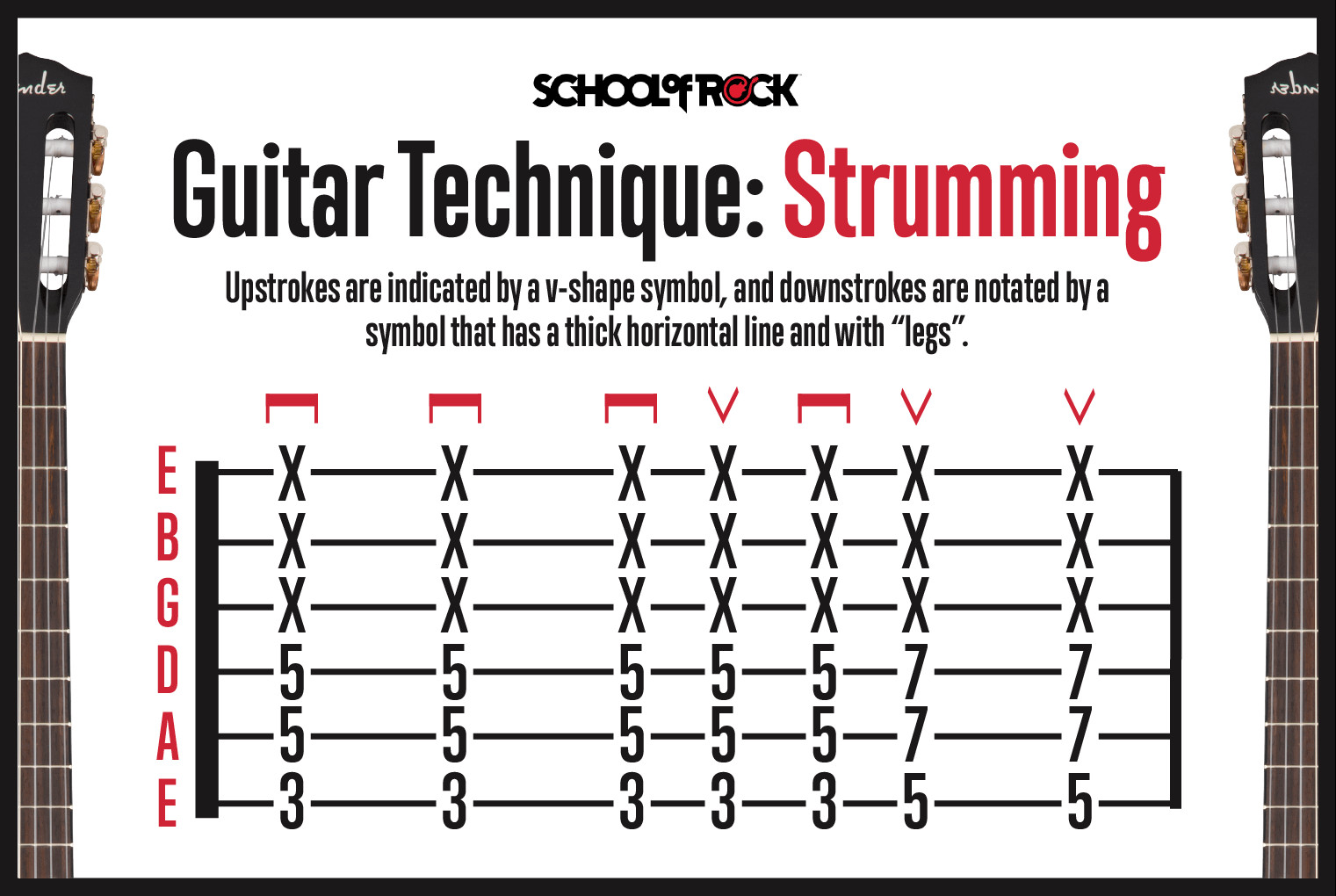 Guitar technique strumming
Guitar technique strumming
Image alt text: Illustration of strumming techniques in guitar chords tablature, showing downstroke and upstroke symbols and hand motion.
How to Strum Rhythms
Strumming patterns vary depending on the song’s rhythm. Common patterns involve combinations of downstrokes and upstrokes. For rhythms based on eighth notes (counted as “1 and 2 and 3 and 4 and”), many songs use alternating downstrokes and upstrokes, with downstrokes on the numbered beats (1, 2, 3, 4) and upstrokes on the “ands.”
Downstrokes and Upstrokes for Single Notes
The same downstroke and upstroke notation applies to single notes in a guitar chords tablature chart. Downstrokes (horizontal bar with legs) indicate a downward pick motion, and upstrokes (“V”) indicate an upward pick motion.
Ready to Explore More Guitar Techniques?
Now that you understand how to read guitar chords tablature charts and various guitar techniques, you’re equipped to start playing! From beginner to advanced levels, guitarplayers.net is dedicated to helping you achieve your musical aspirations. From basic strumming to advanced tapping, our resources offer the knowledge and guidance to quickly learn your favorite songs.
Ready to find guitar chords tablature charts? Whether you’re looking for easy beginner songs or challenging pieces, guitarplayers.net provides access to a wide range of tablature resources.
Thinking about a new guitar? Explore our Guitar Buying Guide
